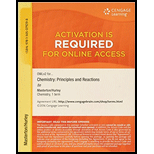
Concept explainers
Atomic Theory and Laws
State in your own words the law of conservation of mass. State the law in its modern form.
Interpretation:
The law of conservation of mass should be stated in your words and in its modern form.
Concept introduction:
Dalton’s atomic theory explains that all matter composed of atoms, indestructible and indivisible building blocks and all the atoms of an element are identical.
It also explains that atoms of different elements vary in mass and size.
This atomic theory states that all the compounds contain combinations of atoms in definite ratios.
It also states the rearrangement of atoms in the product and reactant compounds is resulted by a chemical reaction.
Answer to Problem 1QAP
Law of conservation of mass states that the there is no change in the mass in a chemical reaction.
In modern form, the law of conservation of mass is the energy can neither be destroyed nor be created. It is always conserved.
Explanation of Solution
Three basic laws are explained by the Dalton’s atomic theory that is law of conservation of mass, law of constant proportions and law of multiple proportions.
Law of conservation of mass: This law states that during a reaction process or in a chemical reaction, there is no change in the mass of reactants or mass of reactant is equal to the mass of product.
In modern form, the energy or its form can neither be destroyed nor be formed is the law of conservation of mass. It is always conserved.
Law of conservation of mass states that the there is no change in the mass in a chemical reaction.
In modern form, the law of conservation of mass is the energy can neither be destroyed nor be created. It is always conserved.
Want to see more full solutions like this?
Chapter 2 Solutions
CHEMISTRY:PRIN.+REACTIONS-OWLV2 ACCESS
- Nonearrow_forwardThe U. S. Environmental Protection Agency (EPA) sets limits on healthful levels of air pollutants. The maximum level that the EPA considers safe for lead air pollution is 1.5 μg/m3 . If your lungs were filled with air containing this level of lead, how many lead atoms would be in your lungs? (Assume a total lung volume of 5.40 Larrow_forwardDuring a(n) ________ process, energy is transferred from the system to the surroundings. exothermic endothermic thermodynamic thermochemical physicalarrow_forward
- Use the following information to determine the enthalpy for the reaction shown below. → S(s) + O2(g) SO2(9) ΔΗ Π ? Reference reactions: S(s) + O2(g) SO3(9) 2SO2(g) + O2(g) → 2SO3(g) AHxn = -395kJ AHrxn = ― -198kJarrow_forwardQ1. (a) Draw equations for homolytic and heterolytic cleavages of the N-H bond in NH3. Use curved arrows to show the electron movement. (b) Draw equations for homolytic and heterolytic cleavages of the N-H bond in NH4*. Use curved arrows to show the electron movement.arrow_forwardIndicate which of the following is not an element in its standard state at 25oC and 1 atm. Group of answer choices O2(g) H2(g) Ne(g) N(g) C(s, graphite)arrow_forward
- 6. Show how you would accomplish the following transformations. (Show the steps and reagents/solvents needed) 2-methylpropene →2,2-dimethyloxiran Iarrow_forward4) Answer the following exercise with curved arrows indicating who is a nucleophile or Who is the electrophile? 2.44 Predict the structure of the product formed in the reaction of the organic base pyridine with the organic acid acetic acid, and use curved arrows to indicate the direction of electron flow. 7 H3C OH N Pyridine Acetic acidarrow_forwardUsing the data provided please help me answer this question. Determine the concentration of the iron(Ill) salicylate in the unknown directly from to graph and from the best fit trend-line (least squares analysis) of the graph that yielded a straight line.arrow_forward
 Chemistry: Matter and ChangeChemistryISBN:9780078746376Author:Dinah Zike, Laurel Dingrando, Nicholas Hainen, Cheryl WistromPublisher:Glencoe/McGraw-Hill School Pub Co
Chemistry: Matter and ChangeChemistryISBN:9780078746376Author:Dinah Zike, Laurel Dingrando, Nicholas Hainen, Cheryl WistromPublisher:Glencoe/McGraw-Hill School Pub Co Chemistry & Chemical ReactivityChemistryISBN:9781337399074Author:John C. Kotz, Paul M. Treichel, John Townsend, David TreichelPublisher:Cengage Learning
Chemistry & Chemical ReactivityChemistryISBN:9781337399074Author:John C. Kotz, Paul M. Treichel, John Townsend, David TreichelPublisher:Cengage Learning Chemistry & Chemical ReactivityChemistryISBN:9781133949640Author:John C. Kotz, Paul M. Treichel, John Townsend, David TreichelPublisher:Cengage Learning
Chemistry & Chemical ReactivityChemistryISBN:9781133949640Author:John C. Kotz, Paul M. Treichel, John Townsend, David TreichelPublisher:Cengage Learning General Chemistry - Standalone book (MindTap Cour...ChemistryISBN:9781305580343Author:Steven D. Gammon, Ebbing, Darrell Ebbing, Steven D., Darrell; Gammon, Darrell Ebbing; Steven D. Gammon, Darrell D.; Gammon, Ebbing; Steven D. Gammon; DarrellPublisher:Cengage Learning
General Chemistry - Standalone book (MindTap Cour...ChemistryISBN:9781305580343Author:Steven D. Gammon, Ebbing, Darrell Ebbing, Steven D., Darrell; Gammon, Darrell Ebbing; Steven D. Gammon, Darrell D.; Gammon, Ebbing; Steven D. Gammon; DarrellPublisher:Cengage Learning Chemistry: The Molecular ScienceChemistryISBN:9781285199047Author:John W. Moore, Conrad L. StanitskiPublisher:Cengage Learning
Chemistry: The Molecular ScienceChemistryISBN:9781285199047Author:John W. Moore, Conrad L. StanitskiPublisher:Cengage Learning





